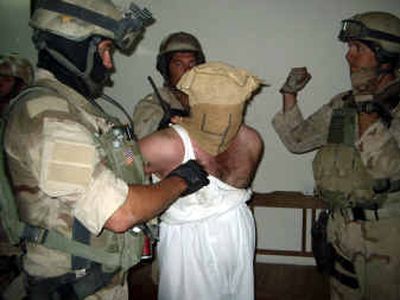SEAL photos show possible prisoner abuse

CORONADO, Calif. – The U.S. military has launched a criminal investigation into photographs that appear to show Navy SEALs in Iraq sitting on hooded and handcuffed detainees, and photos of what appear to be bloodied prisoners, one with a gun to his head.
Some of the photos have date stamps suggesting they were taken in May 2003, which could make them the earliest evidence of possible abuse of prisoners in Iraq. The far more brutal practices photographed in Abu Ghraib prison occurred months later.
An Associated Press reporter found more than 40 of the pictures among hundreds in an album posted on a commercial photo-sharing Web site by a woman who said her husband brought them from Iraq after his tour of duty. It is unclear who took the pictures, which the Navy said it was investigating after the AP furnished copies to get comment for this story.
These and other photos found by the AP appear to show the immediate aftermath of raids on civilian homes. One man is lying on his back with a boot on his chest. A mug shot shows a man with an automatic weapon pointed at his head and a gloved thumb jabbed into his throat. In many photos, faces have been blacked out. What appears to be blood drips from the heads of some. A family huddles in a room in one photo and others show debris and upturned furniture.
“These photographs raise a number of important questions regarding the treatment of prisoners of war (POWs) and detainees,” Navy Cmdr. Jeff Bender, a spokesman for the Naval Special Warfare Command in Coronado, said in a written response to questions. “I can assure you that the matter will be thoroughly investigated.”
The photos were turned over to the Naval Criminal Investigative Service, which instructed the SEAL command to determine whether they show any serious crimes, Bender said Friday. That investigation will determine the identities of the troops and what they were doing in the photos.
Some of the photos recall aspects of the images from Abu Ghraib, which led to charges against seven soldiers accused of humiliating and assaulting prisoners. In several of the photos obtained by the AP, grinning men wearing U.S. flags on their uniforms, and one with a tattoo of a SEAL trident, take turns sitting or lying atop what appear to be three hooded and handcuffed men in the bed of a pickup.
A reporter found the photos, which since have since been removed from public view, while researching the prosecution of a group of SEALs who allegedly beat prisoners and photographed one of them in degrading positions. Those photos, taken with a SEAL’s personal camera, haven’t been publicly released.
Though they have alarmed SEAL commanders, the photographs found by the AP do not necessarily show anything illegal, according to experts in the laws of war who reviewed the photos at AP’s request.
Gary Solis, a former Marine Corps prosecutor and judge who teaches at the United States Military Academy, said the images showed “stupid” and “juvenile” behavior – but not necessarily crimes.
John Hutson, a retired rear admiral who served as the Navy’s Judge Advocate General from 1997 to 2000, said they suggested possible Geneva Convention violations. Those international laws prohibit souvenir photos of prisoners of war.
“It’s pretty obvious that these pictures were taken largely as war trophies,” Hutson said. “Once you start allowing that kind of behavior, the next step is to start posing the POWs in order to get even better pictures.”
At a minimum, the pictures violate Navy regulations that prohibit photographing prisoners other than for intelligence or administrative purposes, according to Bender, the SEALs spokesman.
All Naval Special Warfare personnel were told that prior to deployment, he said, but “it is obvious from some of the photographs that this policy was not adhered to.”
The images were posted to the Internet site Smugmug.com. The woman who posted them told the AP they were on the camera her husband brought back from Iraq. She said her husband has returned to Iraq. He does not appear in photos with prisoners.
The Navy goes to great lengths to protect the identities and whereabouts of its 2,400 SEALs – which stands for Navy Sea, Air, Land – many of whom have classified counterterrorist missions around the globe.
Out of safety concerns, the AP is not identifying the woman who posted the photos.